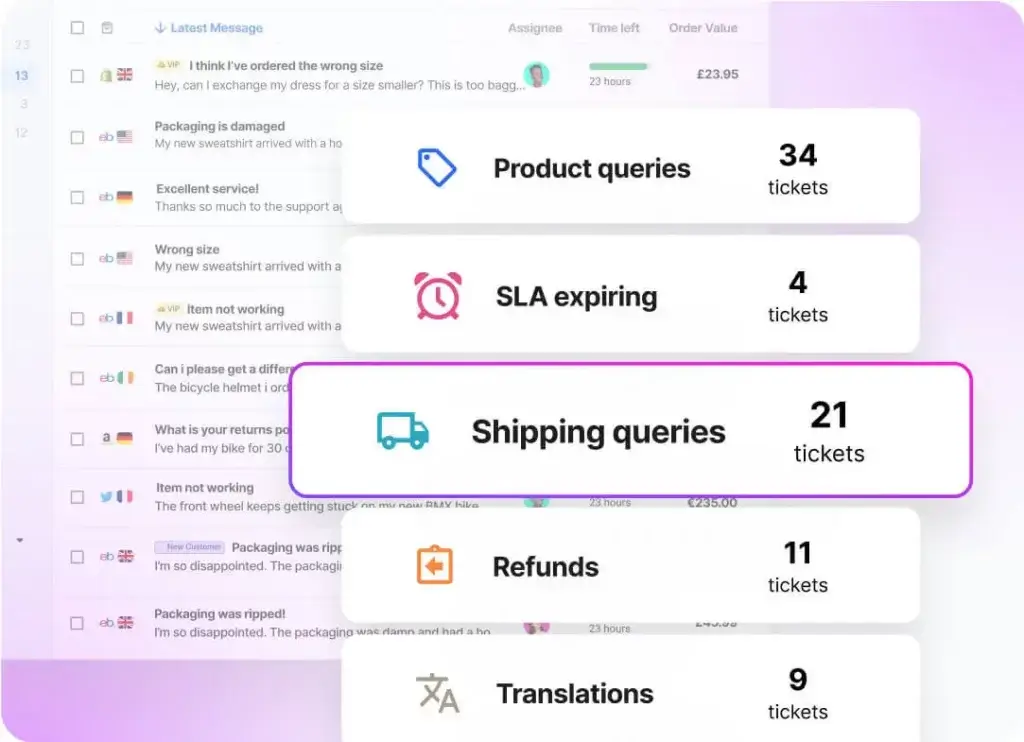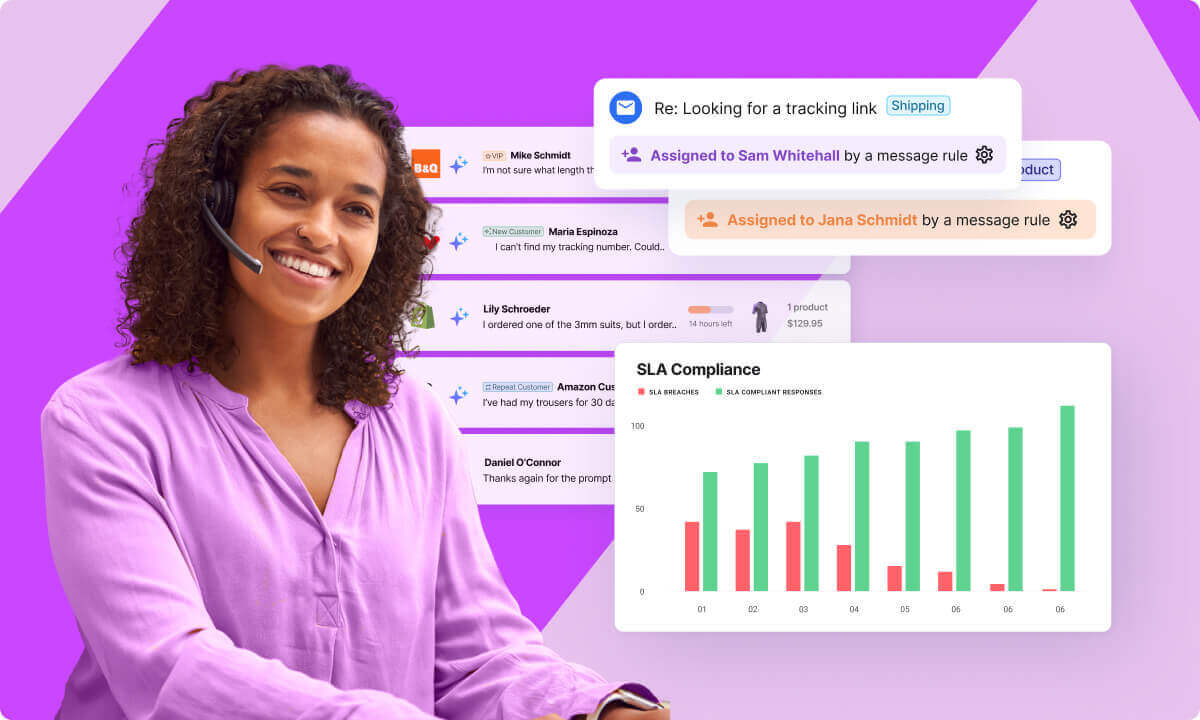Scaling your eCommerce customer service team requires a mix of strategic planning and smart implementation of tactics. Whether it’s for a seasonal peak or market expansion, customer service scaling can be a challenge to profitability and a barrier to growth. Having supported thousands of online sellers to scale their customer service operations, here are our top tips for getting it right the first time.
When scaling up your customer support team for a peak season or for longer term anticipated growth, there are several challenges such as accurately forecasting demand to prevent understaffing and ensuring the quick, effective training of new hires. Balancing technology use with a personal touch is crucial to avoid customer alienation.
Upholding service quality with a larger, potentially remote team requires robust quality control and communication strategies. Additionally, maintaining staff morale to prevent burnout is essential for retaining service excellence. Securely managing customer data during this busy period is vital, as is a smooth transition post-holiday to downsize without losing talent or disrupting service.
Here are our top tips to ensure you and your team are successful as you scale:
1. Get ready: equip yourself with insights

Remember, a well-thought-out game plan is your first step towards an efficient scaling journey. Basing decisions on hard data rather than guesswork and utilizing today’s technological advances are the building blocks of a robust support foundation designed to withstand any customer influx. Invest time in preparation — it will pay dividends when the rush ultimately comes.
Tip 1: Dive into historical support metrics.
As you lay out plans to expand your eCommerce customer support team, it’s imperative that you first look into the previous year’s data. Take note of key indicators such as ticket volumes, response times, and resolution rates during your busiest seasons. This will provide a benchmark for what’s to come, based on the anticipated order volume growth.
Help desk solutions such as eDesk offer powerful built-in reports to help you analyze, understand and share key metrics about your support team, your customers, products, and sales. You will be equipped to compare and analyze customer satisfaction data, SLA compliance, channel and agent performance, ticket volumes and more. Remember that digging through historical figures isn’t an exercise in regret but rather an opportunity for improvement—every missed call or unhandled ticket signifies a missed opportunity AND a lesson learned.
Tip 2: Make data-driven projections for expected demands.
By analyzing past metrics along with anticipated business growth, make realistic projections of this year’s demands on your customer support process. It goes without saying that periods like Black Friday or Christmas could bring about peaks in demand worth preparing for. Be aware of the relationship between your orders and customer query volumes; conscious that different products and sales channels may result in different dynamics.
Granted, forecasting future requirements can have its challenges; changes in buying attitudes or unforeseen market conditions may throw off estimates slightly. However, taking an educated guess still offers more direction than simply leaving things up to chance. Monitor your trends but also those of peers in your category to identify potential shifts in customer behaviors over time or across different markets.
Tip 3: Consider the positive impact AI and automation can have to reduce your staffing needs.
With the wealth of modern technology at our disposal today, implementing AI and automation within your support framework can drastically reduce the strain on human staff during peak periods. AI chatbots never tire nor get overwhelmed by workload — they are designed precisely for handling routine queries round-the-clock, freeing up agents to tackle more complex concerns when scaling support measures.
Moreover, automations can expedite many time-consuming tasks like separating tickets based on topic or urgency level automatically rather than having agents do it manually — an effective way to scale customer support while keeping costs down. Work the potential efficiencies from AI and automation into your projections. For example, here you can see how Pertemba achieved a 42% reduction in their second line response agents by integrating AI and automation into their support strategy. At the same time, they attained an impressive 98% 24-hour SLA compliance rate and experienced a remarkable 45% growth in their marketplace presence.
2. Assemble the troops: smart recruitment

Scaling customer support starts with hiring the right team. As your eCommerce business grows, it becomes increasingly important to refine how you recruit new members to maintain the level of customer satisfaction that facilitated your expansion in the first place.
Tip 4: Prioritize tactical hiring, focusing on key skills.
Tactical hiring should be your mantra when scaling support for your eCommerce venture. Avoid the pitfall of solely increasing team size without careful thought about the unique skill sets required by each role in an expanding team. One helpful measure is drafting a clear job description highlighting specific abilities related to the position; these can range from technical product understanding, communication prowess, multitasking capability or critical thinking skills. Emphasize these during recruitment processes and screen applicants rigorously based on these defined criteria.
When hiring seasonal customer service staff, prioritize candidates with excellent communication, adaptability, and problem-solving skills. Look for quick learners with a customer-first attitude, technical savvy, and the ability to multitask under pressure. Patience, attention to detail, and alignment with your company’s culture are also essential to maintain high service standards during the holiday rush. Focus on recruiting people who can get onboarded quickly into your team and culture to handle first-level support to help you through the peaks.
Tip 5: choose from direct hires, outsourced hires, freelancers.
When considering how to scale customer support strategically, being flexible with your employment model could prove beneficial—direct hires may offer consistency and commitment while external options like outsourcing or freelancing can provide scalability and diversity.
- Direct hires: these are traditional employees who work directly for you. They embody your company’s culture and are committed long-term.
- Outsourced hires: by collaborating with a professional outsourcing firm specializing in providing trained customer service agents, you also gain access to their wealth of expertise in managing customer interactions efficiently.
- Freelancers: opting for freelance professionals allows for quick ramp-up during peak periods without permanent overhead costs rolled over into slack periods.
Consider which approach best complements your current operation before making any definitive decisions.
Tip 6: Implement a streamlined onboarding process with set milestones.
A well-laid out onboarding process has profound implications on your customer support process’ success, directly impacting factors such as productivity and staff turnover. Ideally, you should have a roadmap for each recruit that lists down important milestones within their first few weeks or months.
Setting clear expectations from day one avoids unnecessary confusion later in the journey. Regular check-ins during this initial period allow for constructive feedback exchange and ensure new hires integrate smoothly into their roles. Remember to continually modify your onboarding program based on input from existing and former employees to maximize its effectiveness consistently.
3. Embrace technology: boost efficiency

Having finished assembling your customer support team, the next big leap in scaling customer support lies within embracing technology. Befriending technology not only accelerates processes but also achieves a remarkable efficiency that would be otherwise unattainable. Read on for actionable tips to help you leverage this potential.
Tip 7: Leverage templates and knowledge bases to reduce training demands
In the quest to scale customer support, embarking on lengthy training sessions for every new hire can feel like an uphill slog. This is where pre-existing templates and knowledge bases translate into diamonds in the rough. These tools provide consistent information that recruits can access anytime, reducing training time significantly. These resources help to minimize the risk of less experienced agents pulling up the wrong order or providing incorrect tracking information, which really helps take the pressure off recruits.
An internal knowledge base presents a one-stop-center where staff members find relevant resources ranging from video tutorials to step-by-step guides on handling common queries or issues raised by customers. Similarly, templates – for emails or chat responses – ensure uniformity in communication while saving time spent drafting replies from scratch each time. With solutions like eDesk you can even use smart snippets to auto-insert customer order information from any of your sales channels into your reply templates.
Tip 8: Deploy AI summarizations, sentiment analysis and personalized response suggestions
The echo of artificial intelligence (AI) sounds louder than ever in today’s eCommerce landscape, particularly in regard to enhancing customer service operations. One major aspect entails AI summarization tools which reinforce quick comprehension of large volumes of customer data for effective decision-making. Automated sentiment analysis becomes invaluable when it comes to detecting emotions behind customer communications and assessing overall customer feeling toward your brand.
Personalized response suggestions can help even your most seasoned agents during rush periods; these systems generate apt replies either for approval before dispatch or to serve as inspiration. You can now also leverage AI to craft responses that are more friendly or professional depending on the customer context and your brand tone guidelines. See the power of these types of AI capability for yourself with our AI-powered ticket resolution simulator.
Tip 9: Use AI auto-responses and chatbots to deflect routine queries
Implementing AI auto-responses and chatbots will truly elevate how you scale customer support. These can tremendously assist in managing workload by answering routine, straightforward questions while human agents focus on complex matters. Think of them like tireless helpers that offer instant round-the-clock responses, increasing efficiency and improving customer satisfaction with time-sensitive resolution.
Chatbots use machine learning to evolve, becoming more adept at responding with each interaction. This resembles the compound interest effect; value accrued becomes of immense aid when peak season kicks in. Remember, technology isn’t replacing the human touch; it’s enhancing our capabilities, leaving us better equipped to serve customers efficiently.
4. Smooth operations: optimize processes

Stepping up in scaling customer support success in your eCommerce business also depends on optimizing processes for smooth operations. Streamlined methods are key to achieving faster response times, better service levels and happy customers.
Tip 10: Establish a clear ticket prioritization system
An indispensable element of the customer support process is managing incoming tickets or queries effectively. To achieve this, it’s essential to establish a clear ticket prioritization system. For example, you could categorize tickets into high, medium, and low-priority classes. High-priority tickets might include serious issues like transaction failures or wrong order deliveries, whereas medium and low-priority ones can constitute less time-sensitive problems such as requests for information or feedback submissions.
eDesk’s smart inbox even gives eCommerce businesses the ability to identify and prioritize pre-sales queries, ensuring they receive a prompt response that turns online browsers into buyers. By doing so, your team can focus on attending to severe issues before they escalate, improving customer satisfaction rates while simultaneously scaling support services.
Tip 11: Auto-assign customer queries based on skills and experience
Harness technology not just for ticket routing but also forward allocation of tasks based on team members’ skills and experience. Generally, a fresh recruit would usually receive simpler queries while more complex matters would go to specialists with several years under their belt. This implies that each member deals with concerns they’re most competent at addressing — significantly reducing resolution times and boosting customer confidence in your service.
Make sure that query escalation and collaboration is seamless. New team members will need efficient ways to push queries to more experienced colleagues or external parties. Ticket collaboration can significantly expedite issue resolution and reduce escalations, as junior employees learn swiftly from experienced peers and contribute to a balanced workload, leading to quicker customer responses and time savings.
Tip 12: Ensure all order, delivery, and customer data is immediately available to agents
Guaranteeing immediate access for agents to all necessary data dramatically empowers your scaling customer support efforts – be it order details, delivery schedules or customer communication histories; speed is crucial when resolving disputes. For example, an agent might need to retrieve data from sales, inventory management or logistics within seconds to respond effectively to a customer.
Being able to instantly associate customer messages with their corresponding orders and full history across all sales channels will reduce handling times by providing instant context, allowing for personalized responses at scale. Aim to eliminate the switching between different systems or tabs, to reduce the learning curve for new team members.
5. Keep spirits high: focus on team morale

As you move forward with scaling customer support, it’s important not to lose focus on maintaining a positive and cohesive team environment. Scaling up doesn’t necessarily mean increasing the strain on agents; instead, use this as an opportunity to strengthen team morale by embracing some of the following strategies.
Tip 13: Solicit feedback and reviews from customers to improve performance.
One valuable method of improving your eCommerce customer support is through soliciting feedback from customers themselves. Incorporating this approach not only leads to critical insights about services but also serves as recognition for well-done work. This helps team members understand their areas of strength and potential weaknesses, driving them to continually hone their skills.
Take advantage of automated tools such as our feedback module and post-interaction surveys, or opt for direct communication like follow-up calls. When discussing feedback and CSAT responses with your team, it’s crucial to present the information constructively, focusing on opportunities for improvement and celebrating successes. Emphasize the value of customer feedback in personal growth and the overall enhancement of the team’s service quality.
Tip 14: Ensure balanced workloads with structured shift rotations.
A balanced workload is paramount in sustaining high spirits among your customer support team. Overworking can lead to burnout — while underutilization may foster a sense of unimportance or boredom — both influencing overall productivity negatively. Build performance reports that enable you to quickly identify times of day, agents, channels, query types or even products that give rise to reduce response times or poorer SLA adherence.
Implement structured shifts schedules based on your peak hours and employ smart routing technologies that equitably distribute queries depending on expertise and availability. Such measures are instrumental in preventing fatigue while maximizing agent utilization during heavy traffic periods when you scale customer support efforts. Ensure your new team members are supported with available and experienced colleagues at all times.
Tip 15: Recognize achievements and celebrate successes throughout the period.
Finally, don’t forget the power of recognition. When undertaking a significant project like scaling support teams, celebrating each milestone boosts motivation and fosters a sense of accomplishment among all individuals involved, regardless of their roles’ hierarchy. Recognizing individual performers can be done via monthly rewards or shout-outs during meetings.
At a higher level, sharing overall improvements within specific metrics contributes to creating collective pride in what your company achieves together – fueling further progress down the lane. Remember! In any effective customer support process, the human element is vital. Cultivating a positive work environment is critical to maintaining high team morale and delivering excellent support amid constant growth and change. So, go ahead; rally your troops and ride towards an enhanced eCommerce support experience.
Scaling customer service for your eCommerce business during peak seasons or for long-term growth can seem daunting, but with careful planning, strategic hiring, embracing technology, optimizing processes, and maintaining a positive team environment, it’s entirely achievable.
Help desk solutions like eDesk are integral in this journey, offering invaluable insights and automations that pave the way for a smoother scaling experience. By utilizing data-driven decision-making, integrating AI, and focusing on efficient onboarding and process optimization, your business can sustain and enhance customer satisfaction and loyalty.

